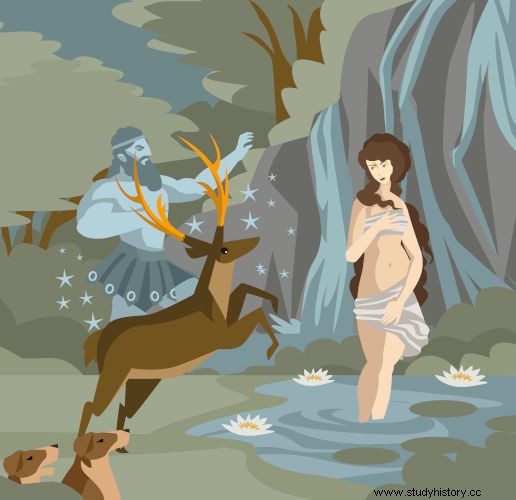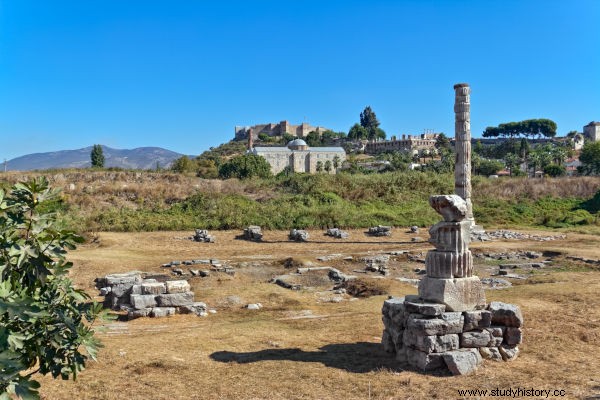
Artemis she was a deity in Greek mythology known as the goddess of hunting, nature and chastity, as well as being the protector of women, children and birth. She was venerated in different parts of Ancient Greece, with cult for her in temples and festivals. The Temple of Artemis in Ephesus was one of the Seven Wonders of the Ancient World.
Go to also :Hades — the Greek god of the underworld
Artemis Summary
-
Artemis was the Greek goddess of hunting, nature and chastity, also considered the protector of women, children and birth.
-
she was the daughter of Leto and Zeus and was also the twin sister of Apollo.
-
The bow and arrow were great symbols of hers.
-
Artemis was venerated throughout Greece.
-
The Temple of Artemis in Ephesus was considered one of the Seven Wonders of the Ancient World.
Artemis in Greek Mythology
Artemis was a Greek deity known for being the goddess of hunting, da nature and chastity . She was considered the patron and protector of women, children and birth. She was one of the most revered goddesses in all of Greece.
This goddess she was daughter of Zeus and Leto and also was Apollo's twin sister , known as the Greek god of the sun. It is narrated that the birth of Artemis was troubled, as Hera, wife of Zeus, turned against Leto, who had become pregnant with the god in an extramarital relationship. Hera had prevented Leto from giving birth anywhere on Earth, which caused her to suffer the pains of childbirth for many months.
Eventually, Leto managed to give birth on Delos, where Artemis and Apollo were born. Versions of the Artemis myths, however, state that she was born in Ortygia. Mythology tells that Artemis was born before Apollo , however variations point out that they would have been born together.
During his childhood, Zeus would have asked what Artemis wanted as a gift. She responded by asking the following:
-
be a virgin forever;
-
have multiple names;
-
own bow and arrow produced by the Cyclopes;
-
having the ability to bring light to places;
-
possess a robe that allows her to hunt;
-
have 60 ocean nymphs as bridesmaids;
-
have 20 Cretan river nymphs to care for her;
-
own all the mountains in the world;
-
win a city all to herself.
Artemis was considered the goddess of the hunt because she possess a bow and arrow and dozens of hunting dogs . Her relationship with hunting has made her commonly associated with some wild animals, such as deer and wild boar.
Her request of her to be eternally a virgin caused her to associate herself with chastity . The fact that she is the protector of young women has earned her the epithet of Artemis Kourotrophos . The Greeks saw Artemis, above all, as a protector, especially of women who were engaged and about to be married.
Artemis is not considered a central figure in Greek myths, although, as mentioned, she was a very important goddess of ancient Greek religiosity. There are certain myths that demonstrate the goddess's propensity to punish those who acted impertinently against her .

A case punishment is that of Orion, the hunter who tried to rape her and was killed for her. In addition to this, there is a well-known myth involving a man named Actaeon. He was the son of a king named Cadmus, and in a certain situation, he went out with friends to hunt in the mountains. After hunting, Actaeon found a valley that belonged to the goddess Artemis, where he saw the goddess naked, bathing in a fountain.
Enraged and embarrassed, Artemis decided to turn Actaeon into a stag. Actaeon's fate turned out to be tragic, as he was chased by his own hounds and killed in front of those he used to go hunting with. There is also the episode where she sent a boar to kill Adonis, who claimed to be a hunter better than she .
This goddess was also mentioned by Homer in the epic poem Iliad, in which the Trojan War is narrated, supposed conflict between the Greeks and the Trojans. In that conflict, she would have sided with the Trojans, because her brother Apollo was the patron god of Troy . One of the Trojan chiefs, Aeneas, would have been healed by Artemis after being wounded in combat.
Read also: Aphrodite — Greek goddess of love, beauty and sexuality
Worship of Artemis
Artemis was one of the most revered goddesses in Ancient Greece , so much so that her cult was extended to the Romans, who called her Diana. Near Ortígia, an island located in the south of the Italian peninsula, the cult of Artemis was strongly influenced by the cult of other goddesses, such as:
-
Isis, goddess worshiped in Egypt;
-
Cybele, goddess worshiped in Phrygia (now Turkey).
The cult of Artemis was also important in other Greek cities, such as Brauro and Perge on the island of Delos. In Brauro, for example, there was a sanctuary that was used for rites of passage performed by young women and brides. This temple was frequented between the 8th century BC. and III BC
In Sparta, the goddess was known as Artemis Agr oh tera , an epithet used to refer to her quality as a goddess of battle. It was common for Spartans to perform animal sacrifices to her before starting a military campaign. They did so during the battles of the Peloponnesian War, for example.
The fact that Artemis had a strong relationship with childbirth led to the greeks make offerings to that goddess whenever a birth was successful . However, it is important to mention that Artemis was not the only Greek goddess associated with pregnancy and childbirth.
The Greeks also held festivals in honor of this goddess, such as the Festival of Artemis , held in Brauro, or the Festival from Amarisia , carried out in the Attica region. Artemis was also widely reproduced in the Greek arts, always carrying a bow and arrow, her two greatest symbols. The deer and hounds were also important symbols of this goddess.
See also: Greek and Roman Gods — What's the Relationship Between Their Names?
Temple of Artemis in Ephesus
When we talk about Artemis, one should mention the Temple of Artemis, built in Ephesus and considered one of the S ete M spills of M undo A old . The cult at this location was also heavily influenced by the cults of Isis and Cybele.

In this Greek city, Artemis was related to fertility, attribute of several other Greek goddesses, such as Hera. Furthermore, this temple was built in the 6th century BC. e it was marked by its large dimensions , being much larger than the Parthenon, one of the most imposing buildings in Athens.
The dimensions of the temple demonstrate the importance of this construction. This temple would have:
-
129 meters long;
-
68 meters wide;
-
128 columns 18 meters high;
-
1.2 meter diameter columns.
The temple was destroyed in the 4th century BC, rebuilt, again destroyed in 267 AD, and then rebuilt again. Eventually, the sanctuary was deactivated and destroyed by the Christians in 401. It is believed that the stones that formed the temple were used in the construction of other buildings in Ephesus.
Currently,there are only temple foundations . The existence of this sanctuary could be proven in the 19th century, when excavations carried out by John Turtle Wood discovered it in 1869.
